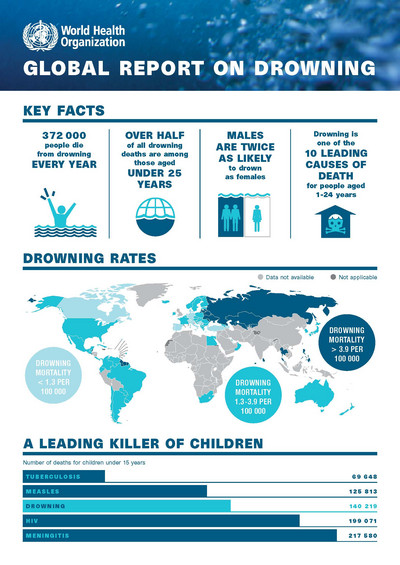Who is Drowning?
What is Drowning?
WHAT IS DROWNING?
Drowning is the process of experiencing respiratory impairment from submersion or immersion in liquid.
Outcomes of drowning may be: death, morbidity or no morbidity. In other words, a person may die from drowning; be injured by a drowning episode; or escape from drowning through rescue or other means.
WHO’S DROWNING?
Drowning is a serious problem. Globally, an estimated one million people drown every year. The World Health Organization reports drowning is the 3rd leading caue of unintentional death in children and youth. In some some countries in Southeast Asia and Western Pacific regions, drowning is the leading cause of unintentional injury among children.
DROWNING IN CANADA
In Canada, drowning is the No. 1 cause of unintentional injury deaths among children 1 – 4 years of age, and the second leading cause of preventable death for children under 10 years of age. With approximately 500 fatalities annually, drowning is the third leading cause of unintentional death among Canadians under 60 years of age (surpassed only by motor vehicle collisions and poisoning).
2020 Saskatchewan Drowning Report
2019 Saskatchewan Drowning Report
2019 Canadian Drowning Report (French)
2018 Saskatchewan Drowning Report
2018 Canadian Drowning Report (French)
2017 Saskatchewan Drowning Report
2017 Canadian Drowning Report (French)
2016 Saskatchewan Drowning Report
2014 Saskatchewan Drowning Report
2009 Saskatchewan Drowning Report
WHO Executive Drowning Report Summary
WHO Drowning Report Infographic
WHO Website (Contains information in other languages)
Lifesaving Society Research
The Lifesaving Society conducts comprehensive research on the causes of both Saskatchewan and Canada's drowning incidents every year. This evidence based research guides the Lifesaving Society and others in developing drowning prevention solutions. The Lifesaving Society's process includes data collection, research tabulation and analysis, and development of reports. A data collection form and process is used to extract the water-related deaths data from the Chief Coroners and Medical Examiners office in all provinces across Canada. The scope of this research includes:
• Collecting the data needed to profile victims of aquatic incidents, including the circumstances and contributing factors under which these incidents occurred.
• Including all deaths in each province and Canada overall resulting from incidents "in, on or near water"; "near-water" incidents were included if the incident was closely related to water-based recreational, vocational or daily living activity, or if the presence of water appeared to be an attraction contributing to the incident.
• Including only preventable (unintentional) deaths. It does not include deaths due to natural causes, suicide, or homicide.
Global Report on Drowning
The WHO Global report on drowning: preventing a leading killer highlights that 372,000 people drown worldwide each year. Drowning is among the ten leading causes of death for children and young people in every region of the world. The report sets out the evidence showing a range of effective drowning prevention strategies, and makes a number of recommendations for concrete measures to be taken by national and local governments. With the release of this report, WHO aims to galvanize attention and action to this issue by highlighting how collaboration across sectors can save lives.
Every hour of every day more than 40 people lose their lives to drowning. Whether it is small children slipping unnoticed into a pond, pool or well; adolescents swimming under the influence of alcohol or drugs; passengers on vessels that capsize; or residents of coastal communities struck by floods, the daily toll of this leading global killer continues its quiet rise.
The Global report on drowning is the first World Health Organization report dedicated exclusively to drowning – a highly preventable public health challenge that has never been targeted by a global strategic prevention effort. This report aims to change this. It sets out current knowledge about drowning and drowning prevention, and calls for a substantial scaling up of comprehensive efforts and resources to reduce what is an intolerable death toll, particularly among children and adolescents.

World Drowning Report 2007
The World Drowning Report is the first of its kind. Published in 2007 by the International Life Saving Federation, the report reviews the current statistical data and literature on drowning mortality. The report concludes that “drowning is a serious threat to world health.






